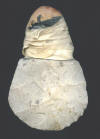

 (Photo LK)
(Photo LK)
Note the hafting method with the wood butting the top of the chert hoe.
This was used to put less pressure on the rawhide and more on the wooden
handle.
MILL
CREEK SPADE
This is another Mill Creek hoe, sometimes
called a spade. The top end, often is left with an unfinished portion to
assist in the wooden hafting. The unfinished portion gives a flat spot for
the chert to abutt the wood. Both notched and unnotched hoes were used to
till the fertile soil of the American Bottoms. The corn and other crops
produced with these tools fed thousands of people for over 200 years.
Here's a spade Larry made last summer. The chert (flint) spade is 7 5/8 in. long.
Hoes and spades were also made of Kaolin flint or chert.
![]() (Photo Bill Iseminger)
(Photo Bill Iseminger)
 (Photo Pete Bostrom)
(Photo Pete Bostrom)
Like most tools, hoes have a second
use. Here, Larry cuts some thatch with the notched hoe. He has backed over
the Big Blue Stem and holds the stems tightly in his left hand while
striking with the hoe. Only 2 or 3 swings are needed to cut the clump. Larry
will then lay the clump in front of him and back over the next clump to be
cut. Thatch can be cut very effectively this way, using only a stone hoe.
(Photo Bill Iseminger)
(photos LK)
These are pictures of a Mississippian shell hoe Larry made in November 2004.
Larry's newest Mill Creek notched hoe. The stone was knapped in 2005 and it was hafted in April 2007.